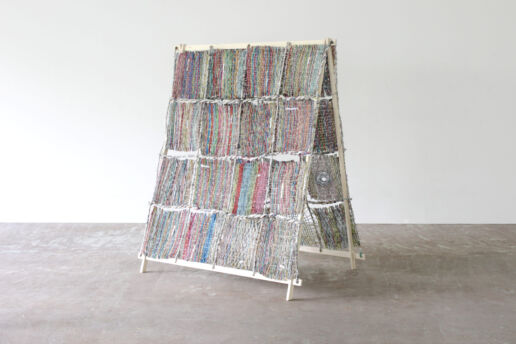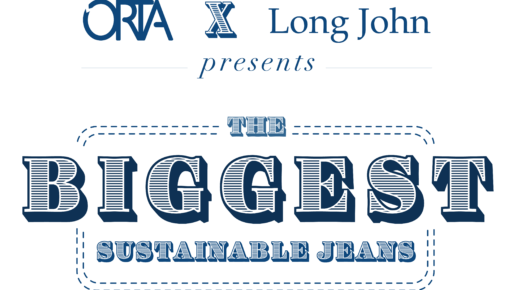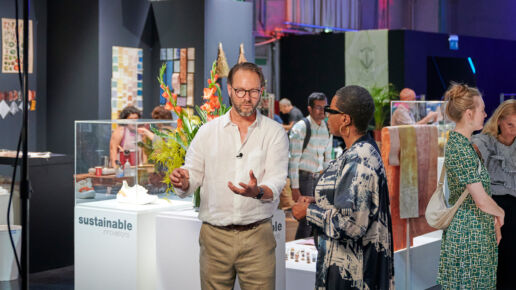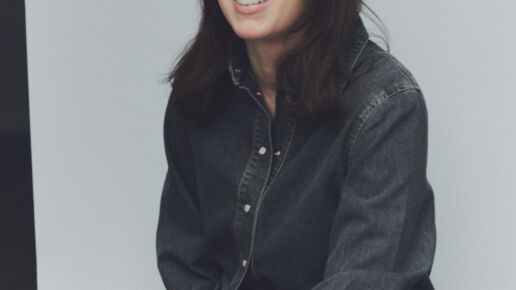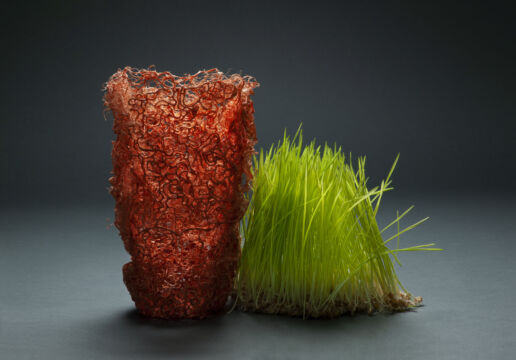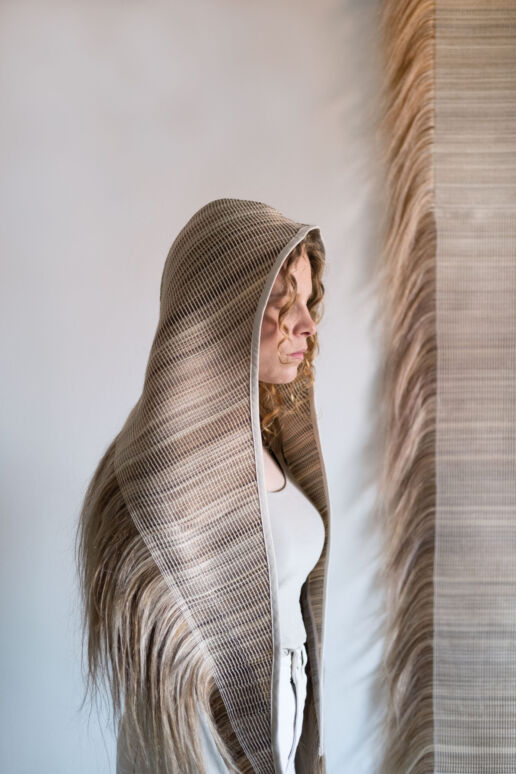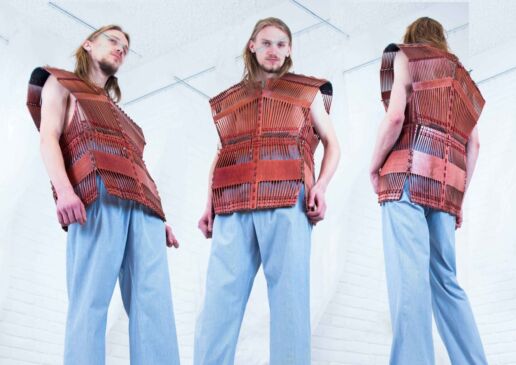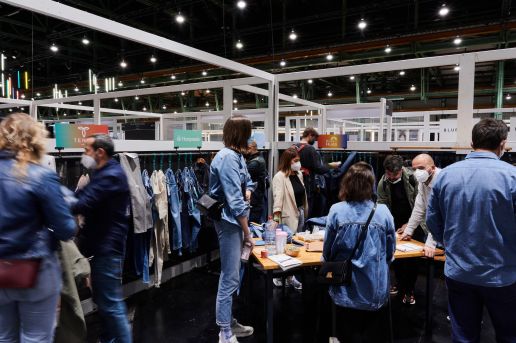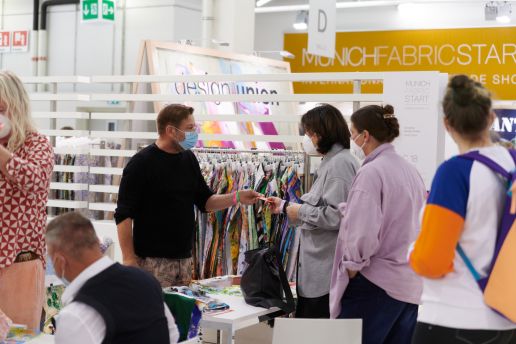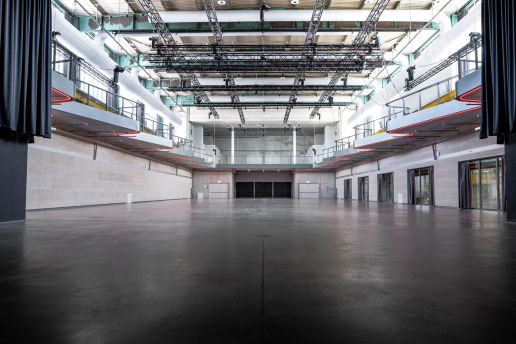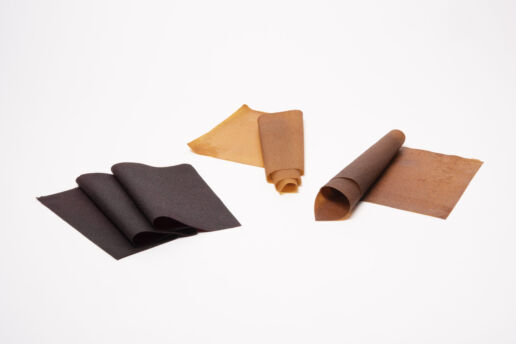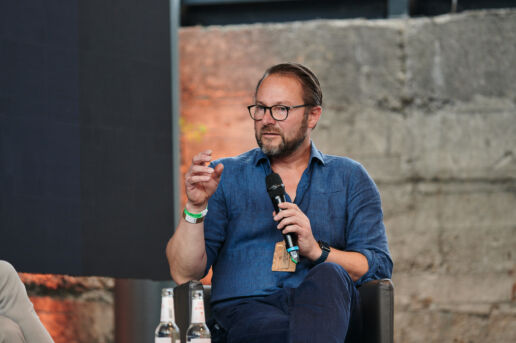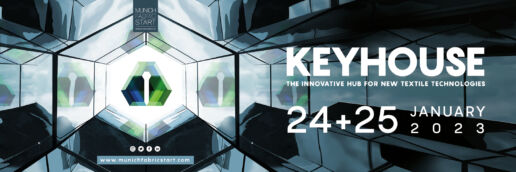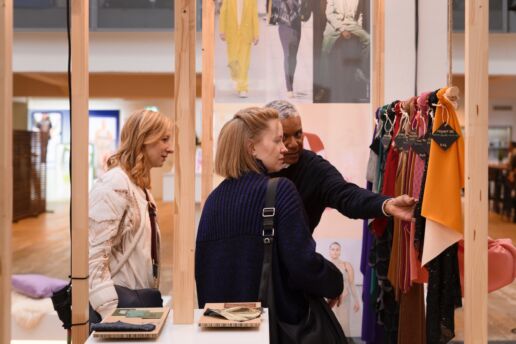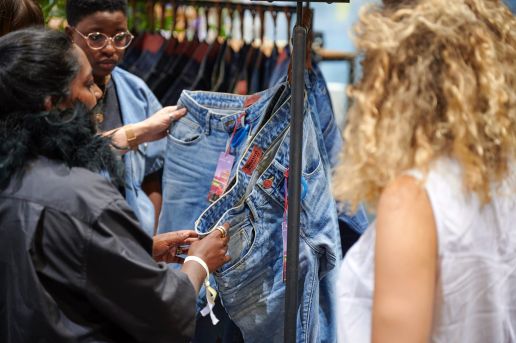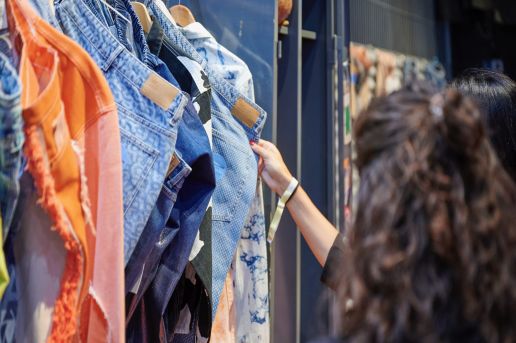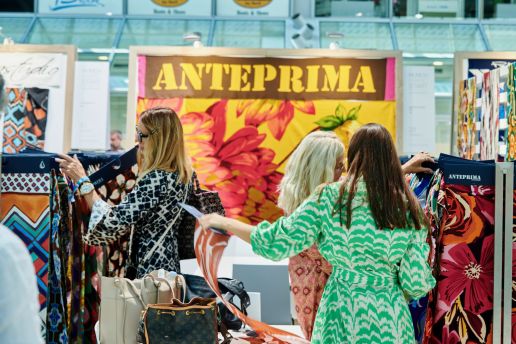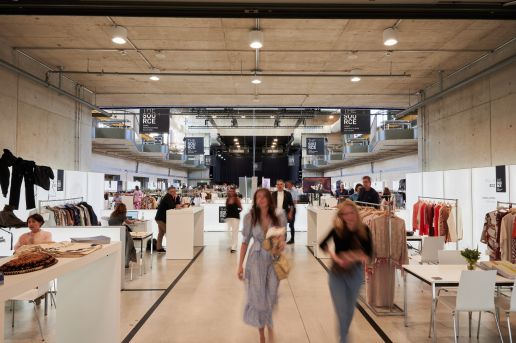Munich Fabric Start
Collective braiding - Sustainable innovations
A world where everything is becoming faster, more connected and more digital, endless possibilities are emerging. But why always strive for the new instead of continuing the traditional?
Designer Camille Champion has taken note of this development and, during a stay in South Korea, set out to revive interest in traditional craftsmanship.
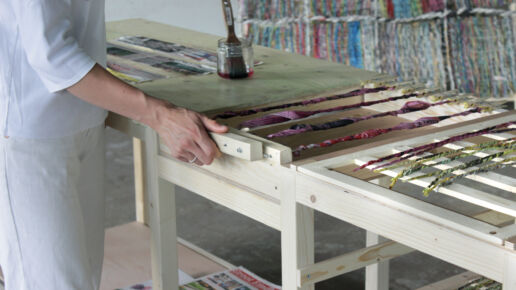
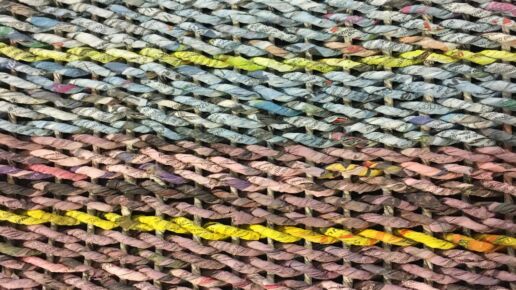
During her travels, she discovered the over 500-year-old technique of jiseung – a process dating back to the Joseon Dynasty that is used to make basketry from old books and paper waste. To do this, the paper is cut into thin strips and then corded. The cords can then be woven into containers such as baskets in various colours and patterns using different basketry techniques.
To save this cultural heritage from extinction, Camille Champion has launched the “Twist and Roll” project, bringing the reuse of newspaper waste to create new objects into a modern Western context: to pass on the craft, the designer has set up a series of workshops to give school children a connection to this tradition. She has designed a small weaving tutorial to teach children to make their own paper threads, weave them on a loom and then collectively build a tent-like structure for their classroom. Twist and Roll combines sustainability, creativity, craft skills and teamwork to show how the education system can benefit from crafts.
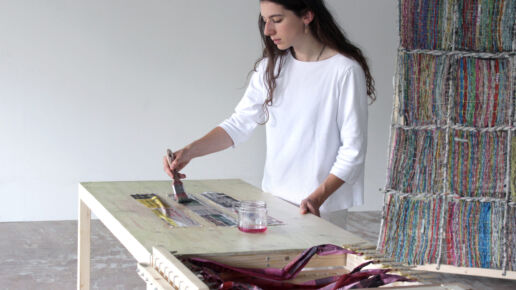
“In my opinion, giving the right tools to the new generations is very important.
Teaching them about materiality, history, or sustainability, will allow them to make the right choices for a better future.”
———————————————————————–
THIS MIGTH BE ALSO INTERESTING FOR YOU
ORTA x Long John
13. January 2024
Togetherthey developed the biggest sustainable jeans everproduced to set a new milestone within the denim industry.
GANNI – Fashion made from next-gen materials
9. January 2024
With all our communication we try to speak to our community in a meaningful and honest, not perfect way, showing the hard stuff, the stuff we didn’t get right, as much as we show the stuff we nailed.
Clothes that grow - Sustainable innovations
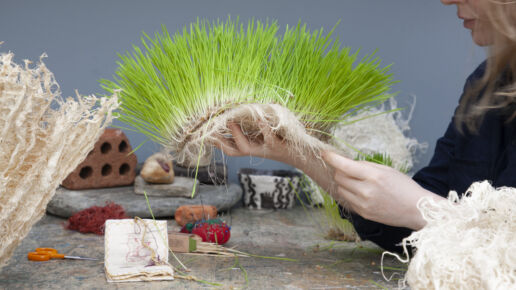
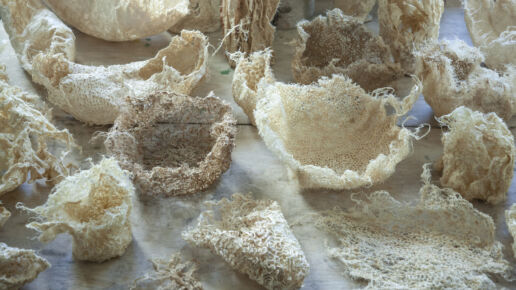
Nature as a 3D printer: material designer and underwater photographer Zena Holloway creates shapes and forms from wheat grass roots that grow in self-carved moulds made of beeswax. The supposed magic lasts for twelve days – the roots spread out horizontally or vertically and make their individual way through the wax templates. Depending on the shape of these, the roots either grow small in a confined space so that they become flat and compact, or if there is more space they can root deeper and three-dimensional shapes emerge. Immediately after harvesting, the roots are heavy and moist, after 24 hours they dry out and become light as a feather.
Each growth cycle produces a different result – all products are therefore individual pieces that can be further shaped by cutting, sewing, tearing or linking. For example, they can be used to create large, hanging structures, to shape vessels or to produce clothing and accessories. The wheatgrass roots also react particularly well to natural dyeing processes. In the name of sustainability: the water that accumulates and runs off during production can be reused and the leftover shoots, seeds or roots can be reused as animal feed. In addition, the dried root is a kind of botanical skeleton that binds carbon. Thus, the Rootful project demonstrates a micro-level approach to solving the complex problem of climate change.
“Growing artefacts from root is the simplest concept but captures the imagination of a wide audience.
I’m learning that root is a wonderful material to create fashion and art, serving to open up conversations around materiality and sustainability that inspire change.“
In the name of sustainability: the water that accumulates and runs off during production can be reused and the leftover shoots, seeds or roots can be reused as animal feed. In addition, the dried root is a kind of botanical skeleton that binds carbon.
Thus, the Rootful project demonstrates a micro-level approach to solving the complex problem of climate change.
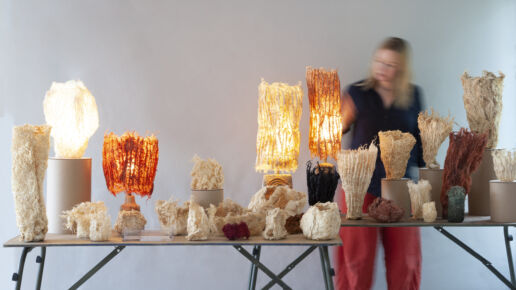
———————————————————————–
THAT MIGHT BE ALSO INTERESTING FOR YOU
ORTA x Long John
13. January 2024
Togetherthey developed the biggest sustainable jeans everproduced to set a new milestone within the denim industry.
GANNI – Fashion made from next-gen materials
9. January 2024
With all our communication we try to speak to our community in a meaningful and honest, not perfect way, showing the hard stuff, the stuff we didn’t get right, as much as we show the stuff we nailed.
Hairy affair - Sustainable Innovation
Hair creates identity – we dye it, style it, create new looks and expressions, and associate ourselves with cultural or social groups. It loses meaning and becomes rubbish to be discarded. In her hair project, Savine School gives hair a second life.
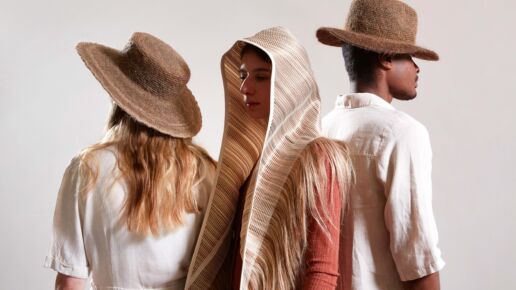
“Haar Haar focuses on the short switch from appreciating hair to feeling disgusted by it, even when it is the same material. It seeks to give a second life
to the material we treasured when it was on our head.“
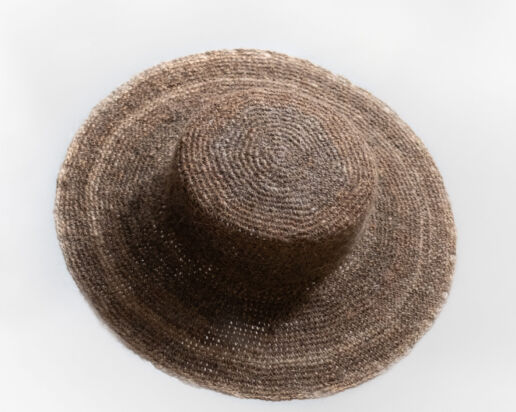
Every month, the textile designer and material researcher collects kilos of hair from various hair salons and extension studios and sorts them by colour and length. In the next step, she uses a machine to spin the hair together with wool into a uniform, flexible yarn. This yarn highlights the properties of both materials: the admixed wool offers the possibility to work with other tones beyond the hair colours, while the reflection of light on the hair provides a beautiful shimmer.
The designer uses the yarn to produce stylish accessories, such as crocheted hats – which at first glance have nothing to do with what ends up on the floor during a visit to the hairdresser. In this way, Savine Schoorl makes it clear that hair is a valuable resource and gives people the opportunity to discover the value of supposed waste in its second life cycle.
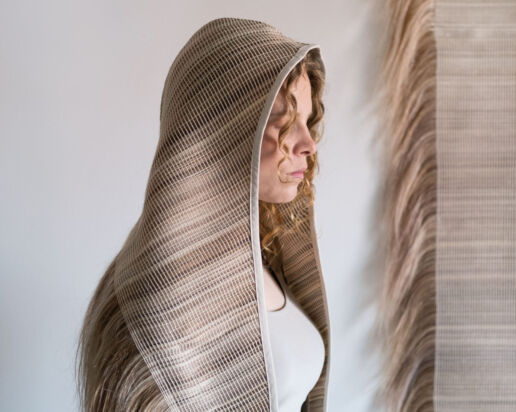
———————————————————————–
THIS MIGHT BE ALSO INTERESTING FOR YOU:
ORTA x Long John
13. January 2024
Togetherthey developed the biggest sustainable jeans everproduced to set a new milestone within the denim industry.
GANNI – Fashion made from next-gen materials
9. January 2024
With all our communication we try to speak to our community in a meaningful and honest, not perfect way, showing the hard stuff, the stuff we didn’t get right, as much as we show the stuff we nailed.
A Suit of Armour - Sustainable innovations
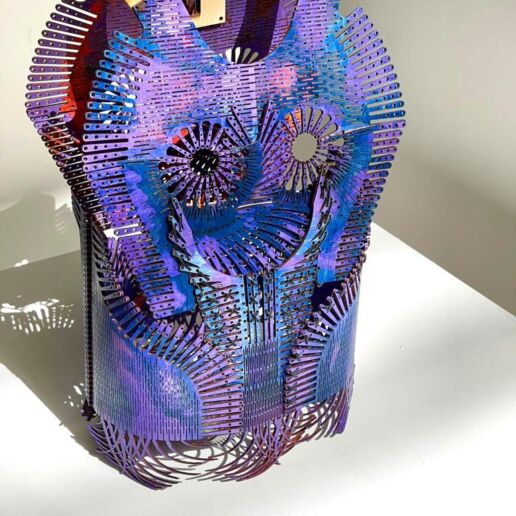
The name says it all: “Choub” means “wood” in Farsi – the material that designer Mehdi Mashayekhi draws on in his project Choub and uses innovative methods to create something new: Using digital fabrication, he has designed an abstract clothing collection for which he deconstructs the wood, giving the material new physical properties such as flexibility and stretchability.
The designer resorts to two methods: with topology optimisation, a computer-based process, he uses algorithmic models to determine the optimal shape of components in terms of load limits. The generative design method also creates new, powerful design options with the help of artificial intelligence. In this way, Mehdi Mashayekhi succeeds in solving complex requirements, distributing the weight of components and reducing manufacturing costs.
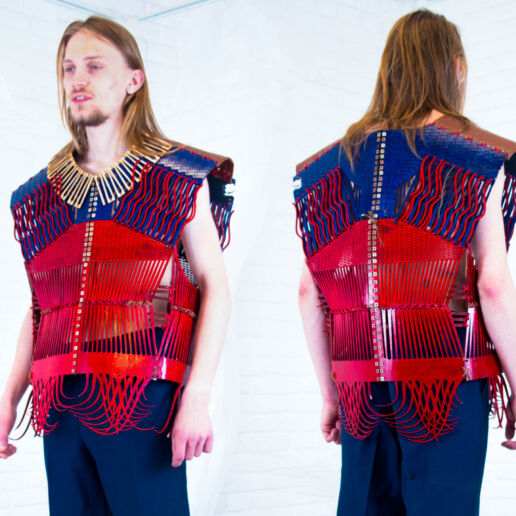
“Design is a glowing point in the cross-point between art and science, where reality meets vision.”
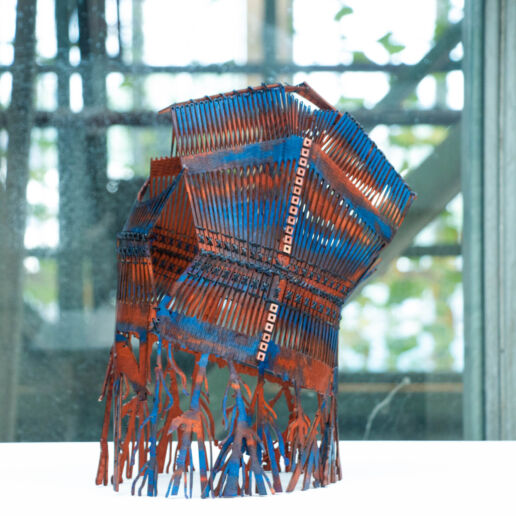
Innovative, unconventional, visionary: In the Choub project, 6mm thick plywood is used to create armour-like, portable constructions in which the wood loses its hardness and becomes flexible. Win-win: The designer optimises the use of materials in the design and at the same time provides a solution for upcycling waste. With the use of digital manufacturing, Mehdi Mashayekhi is helping to drive circularity and strengthen openness to materials and technical textiles.
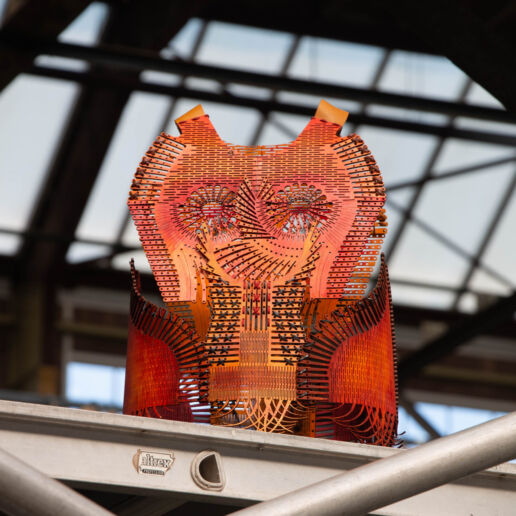
———————————————————————–
THIS MIGHT BE ALSO INTERESTING FOR YOU
ORTA x Long John
13. January 2024
Togetherthey developed the biggest sustainable jeans everproduced to set a new milestone within the denim industry.
GANNI – Fashion made from next-gen materials
9. January 2024
With all our communication we try to speak to our community in a meaningful and honest, not perfect way, showing the hard stuff, the stuff we didn’t get right, as much as we show the stuff we nailed.
A Vibe Shift is coming
Often, fashion trends are merely new variations on already familiar themes over many seasons. But then at some point there is suddenly a fundamental break, a completely new attitude to life, a completely different basic mood, a “vibe shift”. We are now at such a turning point.
The measures necessary to contain Covid 19 have been so all-encompassing that they have actually robbed us of all joy in life in the meantime. Many of us are left with the feeling that we have lost two years of our lives. This is felt particularly intensely by young people who were irretrievably robbed of part of their precious youth by the pandemic.
Greta Thunberg speaks for her entire generation when she says in retrospect: “We have become more aware that life is short.” The realisation that our time on earth is running out far too quickly is anything but new, but it is particularly topical for us now.
Fashion psychology professor Carolyn Mair also observed during the pandemic how consumers “realise that life is precious, whereas before they might have taken things for granted. They are seizing the moment.”
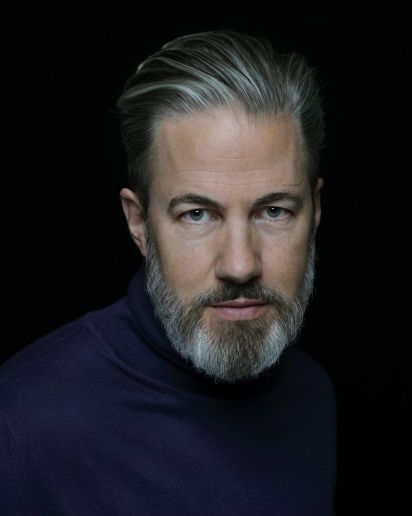
Carl Tillessen
As the 20s take shape, it becomes clear that the Lifestyle of Health and Sustainability, which has dominated the Zeitgeist for the past two decades, has reached its end. Because the L.O.H.A.S. is the opposite of the moment. It is the eternal later. If we chastise ourselves now – so he promises – we will have a healthy body and a healthy environment later. This is and remains true, but through the collective pandemic experience, the fear that we will neglect to enjoy today because of all the thinking about tomorrow has become overwhelming. We crave self-indulgence, need outlets, want to break out, go overboard, want to live as if there is no tomorrow …
GET INFORMED & INSPIRED AT MUNICH FABRIC START AT DMI:
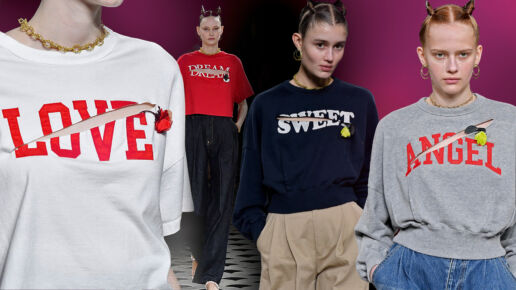
Find out what this means for fashion and what follows the Lifestyle Of Health And Sustainability at MUNICH FABRIC START at the trend presentation of DMI S/S 24
Wednesday, 25 January, at 4:00pm
in Room K1 in front of Hall 1 at MOC.
Discover more industry-changing innovations at our upcoming trade shows:
Textile Innovations: Ready To Be Supercharged in 2023?
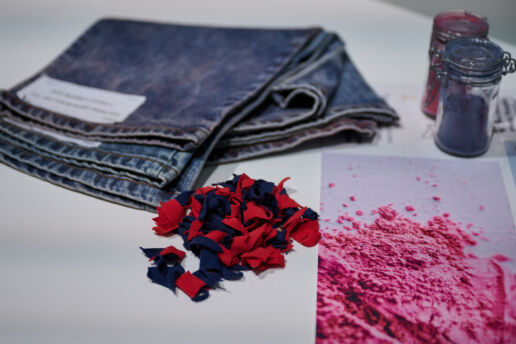
When it comes to textiles, one of the biggest challenges has been the industry taking on the responsibility to examine its processes. Although a necessary step, it is not an easy one for an industry built on foundations that date back to the mid-1700s industrial revolution. The good news is that with the help of new technology, the textiles industry is beginning to become better equipped to address most of the pain points in its supply chain, and in 2023 we may actually witness more innovations than ever being accelerated and scaled.
What To Expect in 2023
In the last few years, a shift in values has been redefining the textile industry. It is a shift driven by various technological solutions created to transform the global textile industry, so businesses can reach their sustainability and circularity goals and also understand the role that policy will most likely play in pushing value-driven fabrics forward.
So with innovation as its backbone, what can industry players seeking a more constructive view of the textile market expect in 2023?
Well, here is an overview of what is expected from the textiles space in 2023:
- There will be an acceleration and scaling of textile technologies that will position companies, small and midsize players, to explore further innovations that will help them align their business so they can adapt their practices and commit long-term.
- New fabrics will no longer survive but thrive as more research into sustainable materials and technologies increases and more brands continue to invest in sustainable and safer innovations.
- The textile industry in 2023 is expected to focus less on decadence and more on authenticity.
- We will witness the adoption of new business models that support sustainability initiatives — including supply chain traceability and the reduction of material usage.
- One of the growth drivers of the global textile market will be increasing demand for environmentally friendly and readily available natural fibres. In addition, more performance and technical fabrics will lean towards natural fibres.
- In 2023, more governments will start imposing stringent regulations. As a result, there will be more pressure on textile manufacturers to be less scattered and unorganised, especially when using toxic dyeing chemicals.
- The landscape will see an increase in market players whose USPs will be strongly driven by new technology and innovations. With a competitive edge, these material innovators bring new growth opportunities and strategies to the market.
- The textiles industry will continue to face materials, manufacturing and sustainability challenges in 2023. However, the good news is that the solutions that will continue to be explored in 2023 will be of a collaborative kind.
- Regarding future proofing manufacturing, 2023 strategies will push forward new research around new materials, digital manufacturing and sustainability for future textiles. In addition, textile manufacturers will create new supply chain models based on vertical integration, nearshoring, and small-batch production.
- In 2023, expect speed and agility to effectively tackle the challenges that slow down the growth of the textile and garment industry.
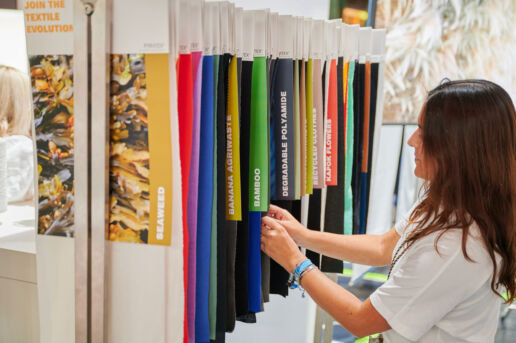
If you take away one thing, let it be this:
don’t be scared by the threat of new textile legislation distracted by the predicted digital shakedown or exhausted by the growing customer demands for sustainability.
Instead, ask yourself, if the future is promised to those who can ride through the challenges by embracing technology across their supply chain, can I afford to shy away from strategically sharpening my approach to the innovative dynamics driving the textile industry in 2023?
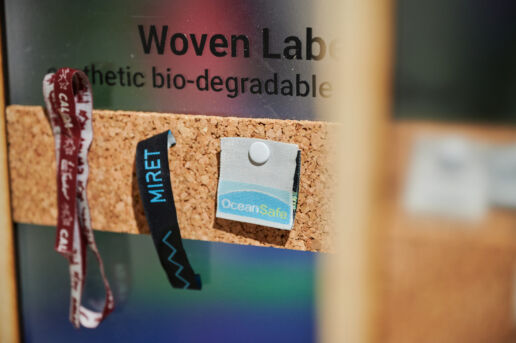
Are you interested in more in-depth facts and figures on the new textile economy?
Visit the Shape Innovate Lounge in H5 | 04 or attend the mini-lectures in the Keyhouse.
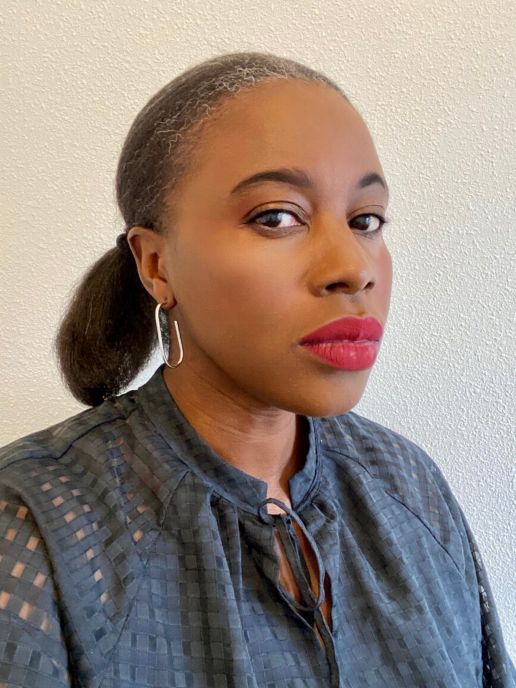
About the author
Founding editor-in-chief of Shape Innovate, Muchaneta has worked in the fashion industry for over 14 years. She is currently one of the leading influencers speaking and writing about the merger of fashion with technology and wearable technology.
Muchaneta ten Napel | m@shapeinnovate.com
This might be also interesting for you
Let’s get circular – Sustainable innovations
16. February 2023
What if the leftovers of freshly squeezed juice were not disposed of - but a new material could be created from it?
The New World of Colours – Sustainable innovations
14. February 2023
Designer Birke Weber and biochemist Friederike Hoberg are exploring the potential of alternative dyes - specifically, from mushrooms.
Collective braiding – Sustainable innovations
9. February 2023
A world in which everything is becoming faster, more networked and more digital creates endless possibilities. But why always strive for the new instead of continuing the traditional?
Clothes that grow – Sustainable innovations
7. February 2023
Nature as 3D printer: Material designer and underwater photographer Zena Holloway creates shapes and forms from wheatgrass roots growing in self-carved molds made from beeswax.
Hairy affair – Sustainable Innovation
2. February 2023
Hair creates identity - we dye and style it, create new looks and expressions and thus assign ourselves to cultural or social groups. They lose their meaning and become garbage to be disposed of.
A Suit of Armour – Sustainable innovations
31. January 2023
The name says it all: "Choub" means "wood" in Farsi - the material that designer Mehdi Mashayekhi draws on in his Choub project, using innovative methods to create something new:
A Vibe Shift is coming
23. January 2023
But then at some point there is suddenly a fundamental break, a completely new attitude to life, a completely different basic mood, a "vibe shift". We are now at such a turning point.
Textile Innovations: Ready To Be Supercharged in 2023?
19. January 2023
When it comes to textiles, one of the biggest challenges has been the industry taking on the responsibility to examine its processes.
“How do our actions contribute to the better?”
18. January 2023
Various developments can be seen - Very interesting and inspiring at the same time: Newcomers are faced with the decision to join the industry or create their own.
Meet Saitex – the vertical Vietnamese Denim Entity
16. January 2023
Global jeans manufacturer Saitex is going vertical as it officially announces the opening of its first denim fabric making
mill in Vietnam.
"How do our actions contribute to the better?"
What is currently happening in the industry of innovators, transformers and forwardthinkers?
Different developments can be observed – especially when it comes to upcoming designers and creators, which is very interesting yet inspiring. Newcomers are about either entering the industry or creating their own one; furthermore, they all developed a very high professionalism in everything they do and how they present their ideas. Storytelling matters, that’s why we see crafts that concern and that communicate about thoughts, materials and backgrounds. They somehow reflect on the state of the industry and/or they question current systems. Just with the eye on possibilities, not to add critique. It is a friendly way to inspire.
You just said creators are “entering the industry or creating their own one”. What do you mean by that?
Well, actually right as I say. Either people and ideas enter an industry OR they create an industry. Entering means that designers or creators just fit into an industry and can get part of it or they can develop their own techniques and make it scalable and somehow create their own. Let me give you an example: WINT Design Lab discovered a new material and also discovered how to use it in order to make it relevant for the market. Either they can enter the industry OR if they find possibilities to cover all the needs within the supply chain and develop the machines to produce in a big scale, they could go big and just create their own industry.
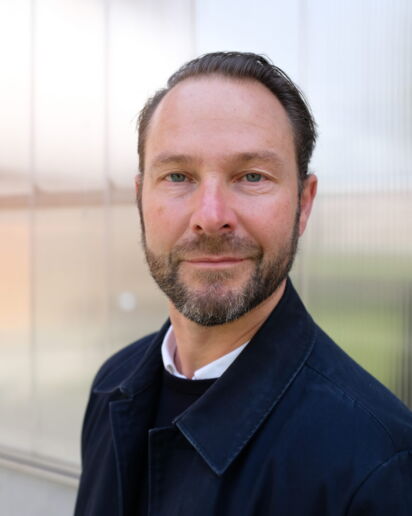
Simon Angel
What other developments can you identify?
Back in the days, let’s say about five years ago, there was mainly one person behind a new idea that was working within a tiny studio. Compared to that, everything is so much more professional: being a material designer, you can have a studio and work with employees who assist. That is nowadays how designers get ready to present their idea to the market. You need people who bridge the gap between the studio and the market. I personally recognize a huge potential in this point of professionalism, because people get ready to connect – young designers now offer representative samples and get in touch with the industry on a very professional level. Newcomers inspire the industry.

What sounds very interesting. What do the newcomers do differently?
Things that impress the industry: crafts that concern and communicate. The designers and their innovations want to tell us stories: it’s about the material, systems (and old behaviours) but also the designs. We can get glimpses into cultural backgrounds, different techniques, social aspects and so much more. For example, the project “Rootful” by Zena Holloway and the project “Choub” by Mehdi Mashayekhi show off how to create a material out of seagrass or wood with the implemented idea to use the finished garment or the designs as tools to communicate.
That’s a positive development, isn’t it?
Yes, it is. But one thing should not be forgotten: we are in the middle of a delicate discussion on the urgency of creating, within that everybody has to
put their own position into a fresh perspective. I sometimes find it important to take a bit of a distance and ask rhetorically questions like: So what? We are
leaving the era of RE-thinking we are entering an era of PRE-thinking. We can challenge ourselves in critical self-reflection with a future smile.
We should not design just to be a designer or cook just for the sake of being a chef. We should not create just to be a creator. We should not just buy new stuff, only for the sake of being a consumer. Way more, we should cook when people need food, design when designs are not good enough and create when the world needs a new product. Let’s stay critical and ask ourselves over and over again: how do our actions contribute to the better?
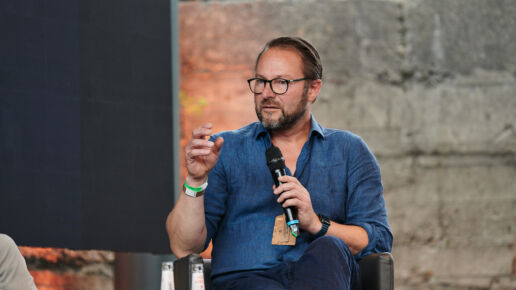
EXPOLRE AND GET INSPIRTED AT MUNICH FABRIC START
IN THE SUSTAINABLE INNOVATIONS AREA AT KEYHOUSE – H5!
Discover more industry-changing innovations at our upcoming trade shows:
Meet Saitex - the vertical Vietnamese Denim Entity
Global jeans manufacturer Saitex is going vertical as it officially announces the opening of its first denim fabric making mill in Vietnam. The new 100,000 square meter facility is located 40 minutes from its cut & sew factory near Ho Chi Minh City where 18,000 pairs of jeans are made on average per day.
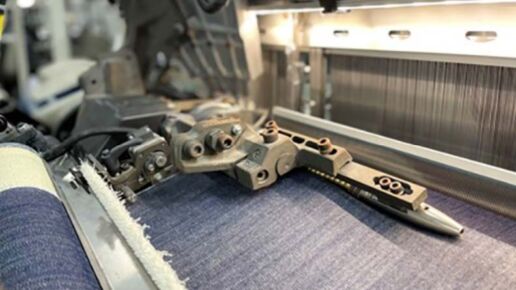
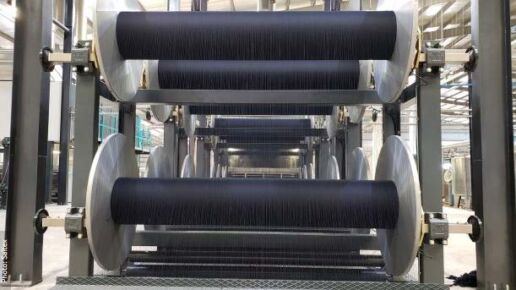
The new mill covers all operations from yarn spinning to weaving and to fabric dyeing and finishing. Saitex has announced it will produce 2 million meters of fabric per month, or 24 million yearly, and some 750 tonnes of yarn per month. These new operations have created 630 new jobs and the company says it will employ 1,000 at full capacity. As it has already done at its cut & sew factory, 20% of the jobs will be filled by people with disabilities.
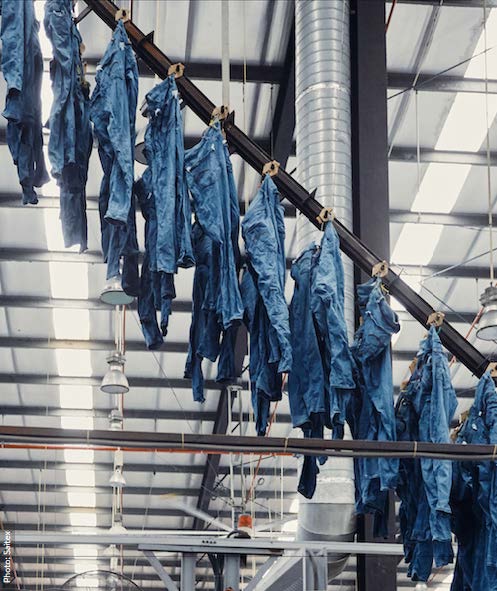
Like Saitex’s “Factory of the Future” in Los Angeles, CA, the new facility incorporates the latest and lowest impact technologies. The mill is equipped to produce yarns in pure cotton or in blends in dual-core, multiple-core and SiroSPUN technologies.
For indigo dyeing, Saitex has installed the Smart Indigo system that pre-reduces indigo via an electrochemical process. This, the company says, leads to lower CO2 emissions by 90%, requires 70% less energy and 30% less water, with oxygen as the only product released. Karl Mayer rope dyeing machines lead to further environmental savings, thanks to fewer dye bathes, and a 30% reduction in indigo and chemical usage.
Other eco-responsible features at the new site include LEED Gold Certified materials for the building, 15,000 solar panels, greywater recycling and rainwater collection systems. A vegetable garden covers 40% of the total site to feed workers and local communities. Saitex says it has also planted 6,000 trees in the industrial park, and has offset its carbon emissions by planting 50 hectares of mangroves in Vietnam, as part of its plan to contribute to climate neutrality by 2025.
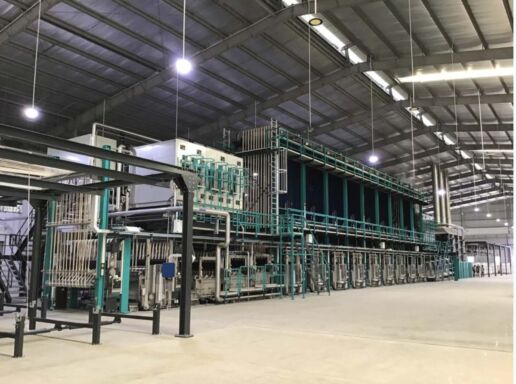

“It has been our long-term vision to close the loop on our operations. With the opening of the mill and the upcoming launch of our textile upcycling facility, Stelapop, our vision will be complete. We will close the circle, allowing us to provide unprecedented transparency in denim production and the ability to turn apparel and textile waste into high-quality goods. Our target is to become the most sustainable fabric mill on the planet making fully circular production possible for our customers.”
Sanjeev Bahl, CEO und Gründer von Saitex
This might be also interessting for you:
Clothes that grow – Sustainable innovations
7. February 2023
Nature as 3D printer: Material designer and underwater photographer Zena Holloway creates shapes and forms from wheatgrass roots growing in self-carved molds made from beeswax.
Hairy affair – Sustainable Innovation
2. February 2023
Hair creates identity - we dye and style it, create new looks and expressions and thus assign ourselves to cultural or social groups. They lose their meaning and become garbage to be disposed of.
A Suit of Armour – Sustainable innovations
31. January 2023
The name says it all: "Choub" means "wood" in Farsi - the material that designer Mehdi Mashayekhi draws on in his Choub project, using innovative methods to create something new:
A Vibe Shift is coming
23. January 2023
But then at some point there is suddenly a fundamental break, a completely new attitude to life, a completely different basic mood, a "vibe shift". We are now at such a turning point.
Textile Innovations: Ready To Be Supercharged in 2023?
19. January 2023
When it comes to textiles, one of the biggest challenges has been the industry taking on the responsibility to examine its processes.
“How do our actions contribute to the better?”
18. January 2023
Various developments can be seen - Very interesting and inspiring at the same time: Newcomers are faced with the decision to join the industry or create their own.
Meet Saitex – the vertical Vietnamese Denim Entity
16. January 2023
Global jeans manufacturer Saitex is going vertical as it officially announces the opening of its first denim fabric making
mill in Vietnam.
DARE & CARE
12. January 2023
"We are continuing the positive, motivated and ambitious mood that is evident at the current shows."
VIEW Premium Selection: leading the way
2. December 2022
In a tense market environment, the exhibiting weavers, producers and accessories manufacturers and
their around 300 pre-collections positioned themselves with strong trend statements and solutionoriented
new developments. Providing confidence and trend-setting answers in uncertain times was
the overriding theme.
VIEW Premium Selection presents some 300 Pre-Collections
23. November 2022
The earliest material and trend information for Spring.Summer 2024 will be provided by the VIEW Premium Selection on 29 and 30 November 2022 at the MVG Museum in Munich. Around 300 pre-collections from international producers will provide information about the new material developments and colours for summer – including numerous newcomers and returnees.
DARE & CARE
1. What can exhibitors and visitors expect at MUNICH FABRIC START in January 2023?
Sebastian Klinder: As an international fabric trade show and Germany’s leading platform for future-relevant textile innovations in the fashion sector, we are once again creating high-quality formats and offerings at MUNICH FABRIC START this season – from a broad and relevant exhibitor portfolio, to top-class lectures and panels, to trend outlooks and numerous opportunities to connect.
We are very pleased that around 900 selected international producers will once again be joining us in Munich in January to show their latest trends and innovations on a total exhibition area of around 42,500 square metres – thus demonstrating that, even in times of uncertainty, we have the courage to think big.
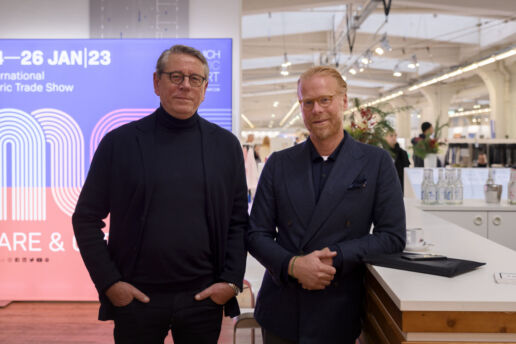
Frank Junker, Creative Director MUNICH FABRIC START; left
Sebastian Klinder, Managing Director MUNICH FABRIC START; right
“We are continuing the positive, motivated and ambitious mood that is evident at the current shows.«
Frank Junker: Nothing ventured, nothing gained – especially now. The conditions are currently changing and this requires openness to new things and the courage to move forward. Not exuberantly, but with care and deliberation. This is also reflected in our motto this year, “DARE & CARE”. Changes are taking place on all levels: from a new sense of community to the struggle for freedom with protests to hedonism and the celebration of the moment; not least the need for islands of tranquility, for joy and above all for real, human encounters. In these topics and controversies, apart from all the uncertainty, lies an immense potential for inspiration and the power to dare something.
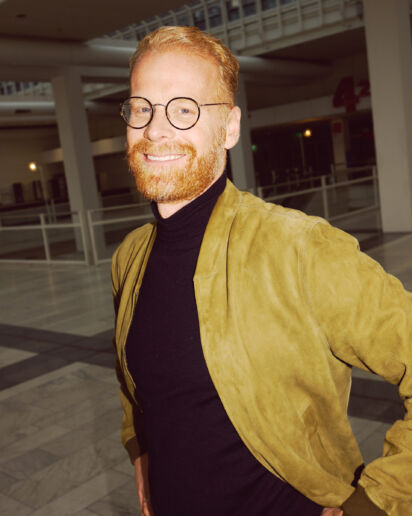
In a volatile market environment, looking ahead optimistically is easier said than done for many. As a trade show organiser, how do you look to the future?
Sebastian Klinder: We are well positioned for the current Spring.Summer 24 edition from 24 to 26 January 2023 and can be very satisfied – in a generally tense situation, MUNICH FABRIC START, BLUEZONE and KEYHOUSE are all very well booked. This makes us quite positive for the future. Demonstrating reliability, relevance and consistency is what matters now.
Frank Junker: Our task is to always be surprising, innovative and at the same time market- and solution-oriented. Once again, we have succeeded in this. Despite all the difficulties, we offer the usual high level of service, create new experiences and form a business and trend and information platform for the strong and relevant partners in the industry. That is what makes us so special. Being special pays off.
3. There is a central change from 2023 – the summer editions of MUNICH FABRIC START, BLUEZONE, KEYHOUSE and THE SOURCE will take place in the second half of July from now on. What do you expect from this?
Frank Junker: With the new date, we are positioning MUNICH FABRIC START and BLUEZONE early in the trade show calendar – so they fit perfectly into the international events and rhythms. We are ontinuing the positive, motivated and ambitious mood that is evident at the current MUNICH FABRIC START with inspiring new products, innovative content and future-oriented themes, placing them in an even more valuable time slot.
Sebastian Klinder: With the new trade show dates for MUNICH FABRIC START and VIEW, we are giving our exhibitors a wide variety of opportunities to respond to the new needs and changes in the market. We are absolutely convinced that this is an important and right step. With our new schedule, we continue to offer the already proven time slots for ordering and move forward confidently and with the courage to change.
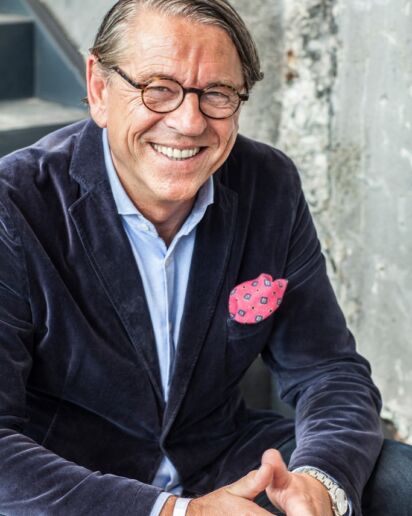
Discover more industry-changing innovations at our upcoming trade shows:
Texfash - Interview
The turnout and excitement at this year’s Munich Fabric Start matched pre-pandemic levels. What were the changes that you noticed in terms of buying practices? What were buyers looking for? Were they more circumspect? Were people taking more measured decisions?
Sustainability has become even more important than before. Many exhibitors have told us that the first questions buyers ask them are: Are your business practices are sustainable? Are your plants certified? Are your products recyclable? Those are no longer questions of marketing; they are questions of the market. Moreover, the conflict situation of skyrocketing energy prices, the current geopolitical unpredictability plus ever imminent shortages of some raw materials are necessitating fast and even further transformations towards more efficient technologies and processes. Everyone at every single position of the supply chain knows that they can no longer afford to waste resources. So yes, people are taking more measured, circumspect decisions.
Another main topic is the discussion about prices. Especially, Germany is a very price sensitive market. There are fixed retail prices brands do not want to change. Now that raw material and energy costs are rising, buyers and product managers are searching for solutions. This is quite challenging if they at the same time want to maintain their high quality and create collections with exciting, fresh and new looks, colours and materials.
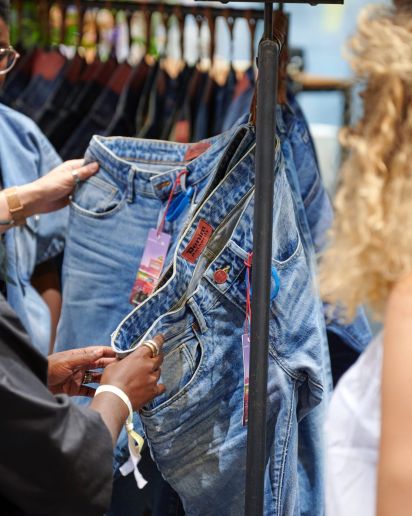
This is also the first time Munich Fabric Start was held since the announcement of the EU Textiles Strategy. Were its overall and long-term implications already reflected this year at MFS? How are companies gearing up?
Many mills and manufacturers are in the midst of or have already shifted to processes that are in accordance with the EU Textiles Strategy. Many denim manufacturers, for example, have adopted dyeing and finishing technologies that work with no or little to no water and entirely without chemicals. Whether it be Muze’s drop dye, Sharabati’s recycling system, Wiser’s oxygen-based, pumice free bleaching process—many have already taken steps to fulfilling the EU’s requirements. In terms of recycling and recyclability, we see that lot of new ideas come up to join forces to use consumer waste as new raw materials to create fashion in circularity. Many countries are looking for solutions. There is a lot to come.
The other thing that has happened, and is still happening, is the Ukraine war. Has it had any impact on Munich Fabric Start in terms of visitors? What was Russian participation like in the earlier years?
To be honest: in this specific case, the first thing we as trade show organisers care about is the people, not our performance indicators or visitor numbers. For sure, this war has an impact on all of us on a way deeper level. During the last couple of days, I had several talks to long-time friends who are affected on a personal level by having relatives in regions that have turned into a war zone, or knowing business partners who had to flee, or just personal memories of travels to places that have now become battle fields. Hearing those stories is heart breaking and it frightens me. On a personal level as well as a professional. Our industry is an exceptionally international one—conflicts are never good for globalisation; armed conflicts and wars even less so.
The Bluezone is a big canvas in itself. It’s a good place to pick up denim trends. How has denim changed since the pandemic?
On an aesthetic trend level, the biggest shift that we see is the concurrency of different trends. Denim is an absolutely ageless phenomenon. And while young generations might be willing to lever heavy qualities from the heritage scene to a wider market, those brands focussing on mid-agers probably tend to source more stretchy ones. The same applies for finishing options. Having said that, we see multiple parallel trends going on in denim. Nevertheless, our own trend forecasters once again identified a meta trend that was able to encompass multiple actual social characteristics and merge them with contemporary ones that move the fashion and design scene—which is why Bluezone’s seasonal theme is ‘Campus’. Under that term we’ve been able to condense a lot of the things that are going on in the denim world right now. And to stimulate education within a community that has a growing mindset and is able and willing to learn and change.
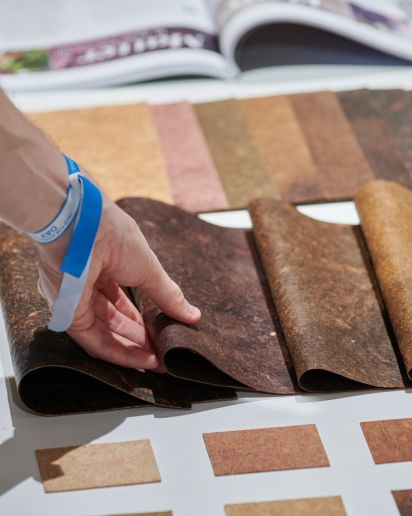
As I have already made apparent earlier, the biggest shift for our whole sector—including the denim universe—is the huge increase in consciousness. Everyone has realised what raw materials are really worth. There is more education around those contexts and a growing interest in details such as social issues or efficiency. We are aware of this demand, which is why we had an extensive series of seminars, lectures and talks at MFS this year, most of which have been centred around circularity, recycling, new materials, traceability and innovations. And we take this matter seriously—we’ve even reached out to enable a ‘coopetitive’ (cooperative competition) cooperation with the Transformer Foundation, resulting in a specialised on stage programme of trans-sectoral discussions and round table talks.
What was the need for The Source, so much so that it needed to be a sub-event and not part of the main Munich Fabric Start?
We actively decided to make it a show-in-show because we wanted to raise awareness for the potential synergies that the simultaneity of a trade show focusing on sourcing and one for fabrics make possible. Think about visiting designers or product managers, and being able to hold meetings with their brand’s fabric producers or even pattern studios and the CMT companies. Our vision is the one of a kind one-stop sourcing ecosystem.


